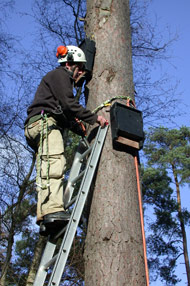The nocturnal life style of bats feeding under cover of darkness makes them particularly difficult to study. However, techniques have been developed to take advantage of their use of echolocation to hunt insects. Bat detectors have been designed to pick up the sounds made by bats as they forage for insects and navigate in the dark. The detectors convert the ultrasound produced by the bat into a frequency audible to the human ear.
A common survey technique is to use bat detectors as an aid to observing bats during their nocturnal activities, whether commuting or foraging. It is also possible to trace their activities to sites where they may be roosting. However, finding roost sites often requires an extended period of observation and could involve the use of radio tracking technology to follow particular bats across a wide area.
Activity surveys can only be completed competently by experienced bat workers or consultants with the appropriate bat detection equipment and preferably with a scientific licence from a Statutory Nature Conservation Organisation (SNCO). Although such people are often assisted by less experienced helpers, to enable much larger areas to be covered. This type of work is unlikely to be completed by the contractor or site manager, but it is important to be aware of the time constraints involved and the influence of seasonal variations in weather and how they affect the bat life cycle.
In large-scale projects it is essential that adequate time is allowed for a bat activity survey. What is involved in such a survey will depend to a great extent on how the site is likely to be affected by the proposed work and how the bats are thought to use the area around it. The initial survey work may only be sufficient to establish the presence of bats using a site, while local records may be able to broaden the picture to indicate which species may be in the area. This means that several visits to a site with a number of surveyors will be required to build up a meaningful picture of which species are present, when, and how they are using the site in question.
More information can be found in the Arboricultural Association Guidance Note - Trees and Bats, written by Andrew Cowan 2004.
Download order form here
For more information e-mail: consulting@arborecology.co.uk
Ecology:
Bats +
[ Activity Survey - Legal Issues
- When an Offence has been
committed - Habitats
regulations licenses ]
|
